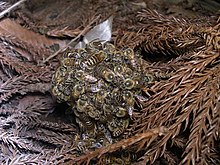Apis cerana japonica
| Apis cerana japonica | |
|---|---|

| |
| The hive of A. c. japonica being scouted by a giant hornet. | |
| Scientific classification | |
| Kingdom: | |
| Phylum: | |
| Class: | |
| Order: | |
| Suborder: | |
| Superfamily: | |
| Family: | |
| Subfamily: | |
| Tribe: | |
| Genus: | |
| Species: | |
| Subspecies: | A. c. japonica
|
| Trinomial name | |
| Apis cerana japonica | |
Apis cerana japonica is a subspecies of honeybee native to Japan. It is commonly known as the Japanese honeybee (ニホンミツバチ, Nihon mitsubachi). This subspecies was determined, through an analysis of mitochondrial DNA, to have originally come from the Korean peninsula.[1] They have been observed moving into urban areas due to lack of natural predators.[2]
A.c. japonica is very resistant to the Varroa jacobsoni mite which is commonly found among A. cerana.[3]
Ecology and behavior

When a hornet scout locates and approaches a Japanese honeybee hive it will emit specific pheromonal hunting signals. When the honeybees detect these pheromones, about one hundred will gather near the entrance of the nest and set up a trap, keeping it open apparently to draw the hornet further into the hive or allow it to enter on its own.[4]
As the hornet enters the nest, a large "ball" (see image, below right) of about five hundred honeybees surround it, completely covering it and preventing it from moving.[5] The bees in the "ball" begin quickly vibrating their flight muscles, raising the internal temperature of the honeybee mass to about 47 °C (116 °F).[5] While the honey bees can tolerate this temperature, the hornet cannot survive more than 46 °C (114 °F) and dies.[4] Several bees may perish along with the intruder, but the death of the hornet scout prevents it from summoning reinforcements which would wipe out the colony.[6]
Beekeepers in Japan attempted to introduce the European honeybee in order to increase honey productivity, but they do not have the same defense against the hornet as A. c. japonica and the colonies are rapidly destroyed when discovered by the hornets.[4][7]
References
- ^ Takahashi, Jun'ichi (2003). "The origin of Japanese honeybee Apis cerana japonica inferred from mitochondrial DNA". Honeybee Science (in Japanese). 24 (2). Japan: 71–76. ISSN 0388-2217. Retrieved 2009-05-05.
{{cite journal}}: Unknown parameter|coauthors=ignored (|author=suggested) (help) - ^ Sugawara, Michio (2000). "Feral colonies of Japanese honeybees, Apis cerana japonica and their life history. 2. Natural nests and swarming". Honeybee Science (in Japanese). 21 (1). Japan: 35–39. ISSN 0388-2217. Retrieved 2009-05-05.
- ^ Takenaka, Tetsuo (1995-08-21). "Royal Jelly from Apis cerana japonica and Apis mellifera" (PDF). Biosci. Biotech. and Biochem. 60 (3). Japan: Japan Society for Bioscience, Biotechnology, and Agrochemistry: 518–520. Retrieved 2009-05-05.
{{cite journal}}: Unknown parameter|coauthors=ignored (|author=suggested) (help) - ^ a b c "Baked Hornet Japonais". Discover Magazine. 1996-02-01. Retrieved 2009-05-05.
- ^ a b Masato Ono, Takeshi Igarashi, Eishi Ohno, and Masami Sasaki (1995-09-28). "Unusual thermal defence by a honeybee against mass attack by hornets". Nature. 377. Nature Publishing Group: 334–336. doi:10.1038/377334a0. Retrieved 2009-05-05.
{{cite journal}}: CS1 maint: multiple names: authors list (link) - ^ "Defensive Adaptations: Heat Tolerance as a Weapon". Davidson College Biology Department. Retrieved 2009-05-05.
- ^ Piper, Ross (2007), Extraordinary Animals: An Encyclopedia of Curious and Unusual Animals, Greenwood Press.
